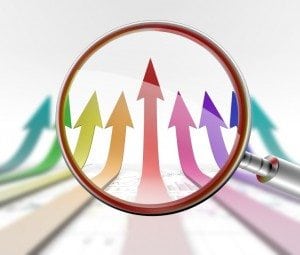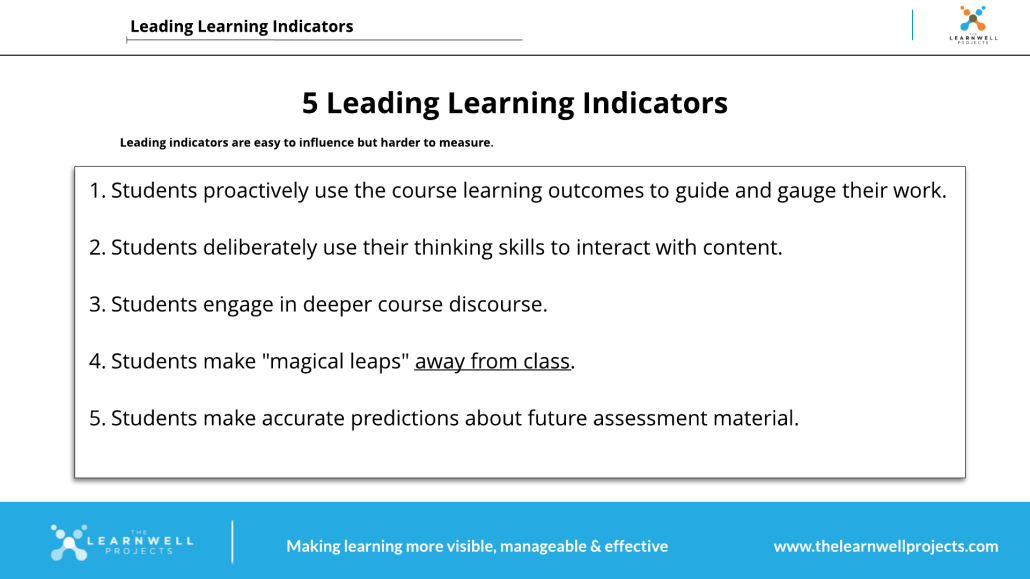[et_pb_section admin_label=”section”]
[et_pb_row admin_label=”row”]
[et_pb_column type=”4_4″][et_pb_text admin_label=”Text”]Abstract: Economists use predictive factors to determine how an economy will perform. In doing so, they must distinguish between information that drives or is correlated with future performance — leading indicators, from data that measure past performance – lagging indicators. Educators and students regularly, unknowingly, mistake lagging indicators for leading indicators. This misinterpretation results in many bad outcomes: teacher frustration, student apathy, underperformance, and overall dissatisfaction with the educational experience. This article separates leading indicators from lagging indicators in learning environments.
As members of the media, policymakers, business leaders, and Americans, in general, consume the continual reports of record corporate profits and the skyrocketing stock market, people are left wondering: Where are the jobs?
This question rests upon an underlying assumption that a job boon should accompany this positive activity. However, economists argue that profits and stocks are leading indicators, while jobs are lagging indicators.
Leading indicators predict — though not always accurately — changes, patterns, or trends in the economy as a whole while lagging indicators usually change after the economy has been restructured. Leading indicators are the proverbial horse that precedes the cart.
Importance of Distinguishing Between Leading and Lagging Indicators
Distinguishing between leading and lagging indicators has a tremendous effect on our motivation and performance. For example, those who have attempted to lose weight should be mindful that healthy eating and exercise are leading indicators, while actual weight loss lags.
I’m sure we all can recall when we were eating healthier and exercising more regularly, yet we became frustrated by the length of time it took for our healthier lifestyle to show results on the scale. If we endured this frustration, we likely experienced a little weight loss. The reduction inspired us to keep up the good work, which, over time, produced more weight loss.
If dropping pounds was easy, everyone would achieve their weight loss goal. We typically abort our new lifestyle when we either explicitly or implicitly calculate that the weight loss isn’t happening fast enough. We then lose our inspiration and gradually abandon our routine.
We didn’t realize we were doomed from the start because we’d set up weight loss, a lagging indicator, as our measure of success. This mistake is common since lagging indicators are easy to measure. It is unrealistic to think that people will sustain their discipline and efforts while waiting for a reward on the back end. If we had used leading indicators, such as healthier eating and exercise, we might have persisted until the weight loss caught up.
Leaders and Laggers in Learning
There are leading and lagging indicators in learning as well. As in pursuing physical fitness, educators and students regularly overlook leaders and focus on laggers. There is a good reason for this oversight. Typically, lagging indicators are easy to measure but difficult to improve, while leading indicators are hard to measure and influence. Refer to our weight loss example: Weight loss, a lagging metric, can easily be measured by simply stepping on a scale, but leading indicators, such as calorie consumption and calories burned, are more time-consuming and difficult to measure consistently.
Students often focus on grades as a measure of their performance. Grades are lagging indicators because they measure how well students have learned (past tense). It’s akin to using the results of an annual physical exam as an indicator of health. The check-up will tell us how we have been doing up to that point. Our lifestyle before the visit is the leading indicator. For the most part, we should be able to predict the results of a physical examination. When students are appropriately focused on factors that accurately predict performance, they can improve their performance.
Controlling Future Performance
Leading indicators are predictive. They drive future performance. Lagging indicators tell us the story of what has happened in the past. Educators and students must know how to distinguish between the two in learning environments and how to influence and measure leading indicators.
Both educators and students must clearly understand how their behaviors impact each other. When educators don’t carry their weight, students suffer. And when students don’t accept their responsibility, they suffer even more.
Whether educators accept it or not, they and their students exist in symbiotic relationships. In-class educators (teachers and professors), out-of-class educators (learning support professionals, guidance counselors, etc.), and students all must be on the same page to maximize performance in the learning economy.
Below are five leading indicators that students can use to measure their learning. If these indicators guide students, high performance is imminent!
The Ideal Learning Economy
I want to conclude this article by sharing my view of how a healthy learning economy should work.
Imagine a learning economy whereby educators organize their instruction around the core outcomes they want students to achieve. They develop general course and lesson-specific outcomes, including the level(s) of cognitive performance. These elements will ensure students know precisely how they will be assessed and evaluated. And what if the outcomes are not only succinctly expressed in the syllabus but are also deliberately highlighted and reinforced during instruction?
When these conditions are in place, students accept their role as co-creators in the educational process. They function as independent learners.
Students understand how to interpret the outcomes against which their performance will be measured. They continually assess their learning by how well they have learned, rather than false metrics, such as how long they’ve studied. Using leading indicators to measure academic work is a game-changer for students, educators, and institutions.
This type of learning economy is not a fantasy; It’s reality!
Is it your reality?
Meet me in the “comments” section below:).[/et_pb_text][/et_pb_column]
[/et_pb_row]
[/et_pb_section]



